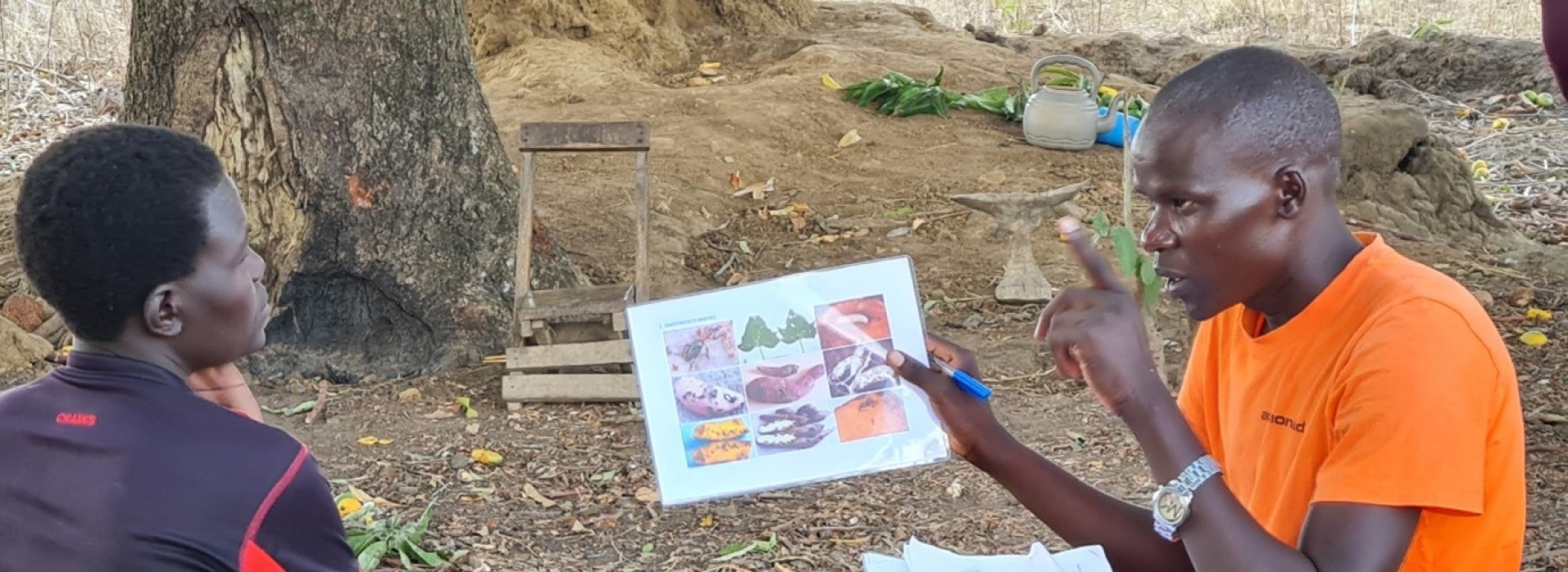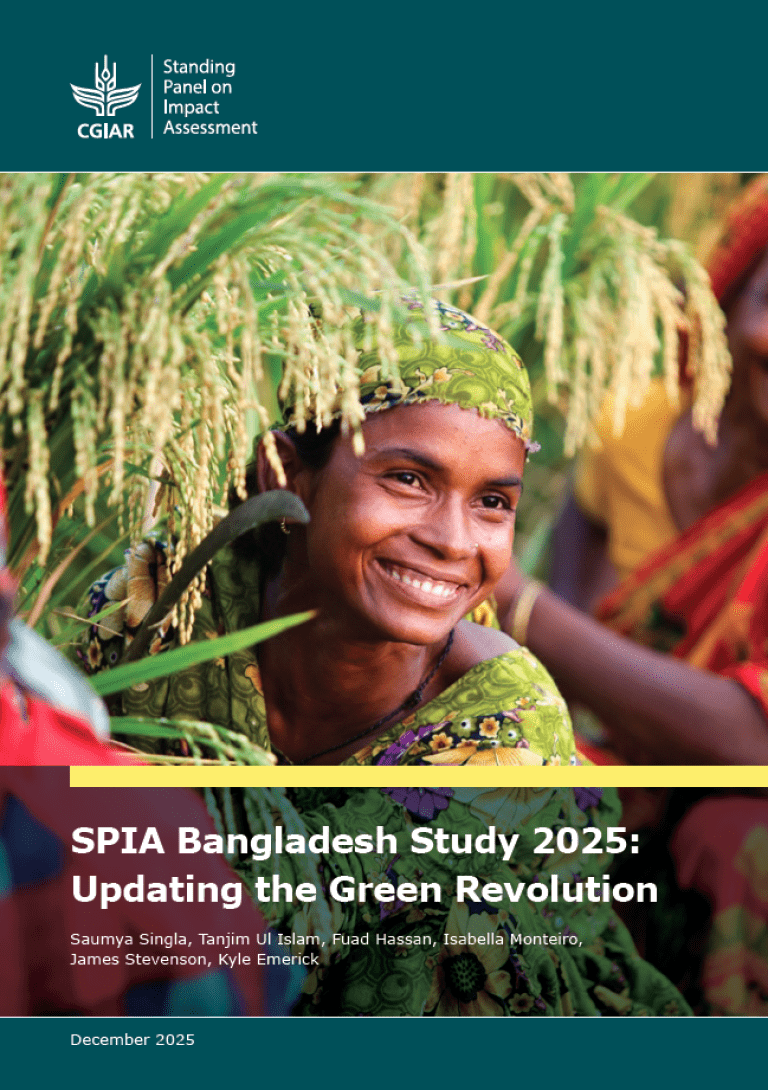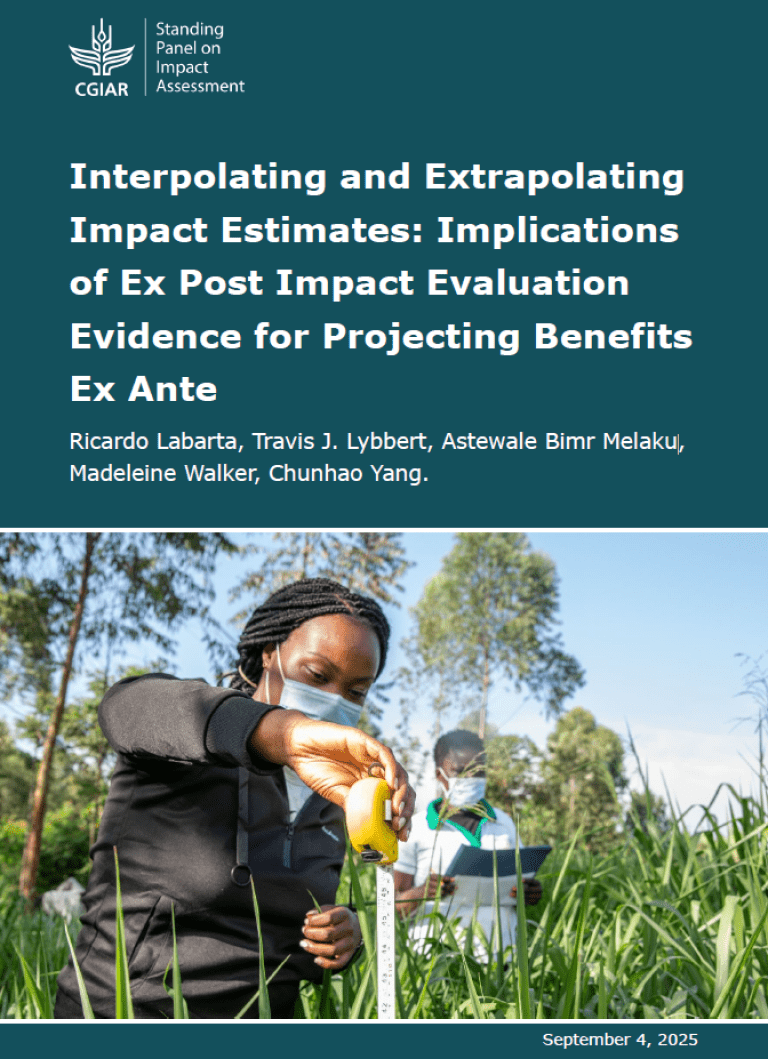Impact Assessment has traditionally played an accountability role in the CGIAR, providing evidence on the returns to research for development investments made in the System. In addition, rigorous impact assessments can also test common assumptions underlying the theory-of-change of different CGIAR innovations and solutions to last-mile delivery problems. The learning role of impact assessment is suitable for the long and complex causal pathways to impact that are characteristic of CGIAR research.
SPIA is engaging CGIAR leadership in promoting a learning agenda for the System, putting value of learning not only from successes, but also from zero- or negative results for specific innovations. Such findings can provide valuable input for adjusting the research strategies or for updating the Theory of Change. Concrete examples on published non-positive results among CGIAR researchers are not common. A recently published paper, however, finds limitations of using Model Farmers to disseminate quality sweetpotato planting material in Uganda. These findings bring new research questions and testable hypotheses that could lead to alternative strategies to increase the uptake of nutritious crops.
The paper, led by behavioral scientists from International Potato Center, Swedish University of Agricultural Sciences and International Livestock Research Institute, investigated the role of social recognition (combined with goal setting), as an incentive for effort provision, in the diffusion of information about agricultural innovations. Studies pioneered by Ariel BenYishay and Mushfiq Mobarak in Malawi suggested that rewarding prosocial behavior (the tendency for people to expend costly effort in doing things that benefit others in their network even when the resulting benefits do not directly accrue to themselves) using extrinsic rewards encourages farmers to spend effort in spreading agricultural information and experimenting with new agricultural innovations. Early studies relied on material incentives, through monetary and in-kind payments. Follow up studies focusing on social incentives, with the most recent one conducted in Ethiopia by scientists at Wageningen University, have largely found similar effects. The Ethiopian study team find that framing social incentives as a loss was more effective in nudging increased effort in disseminating agricultural innovations. A recent study that tested the role of social incentives on the diffusion of knowledge about climate smart technologies in Uganda similarly found that social incentives increase diffusion efforts. In these latter studies, as in the current, social incentive is in form of public recognition of the prosocial behavior of excelling farmers by a high-ranking government officer. Given the precedence, why does the recent Uganda paper matter? Why the contrary findings?
Several factors can help understand the findings of the current paper. These factors range from design to contextual and social. On the design side: First, the disseminating farmers (henceforth, DFs) were selected by local government authorities (i.e., agricultural extension workers and local council chairpersons) from among the progressive farmers who have worked on promoting agricultural innovations in the past. The strategy used in recruiting the DFs in the current study therefore differed markedly from that used in previous studies, which instead targeted randomly selected DFs. Second, the social recognition incentive in the previous studies included a reward for other farmers residing in the same villages as DF. That is, the appreciation of the DF for effort in diffusing agricultural innovations was extended to farmers whose knowledge has been enhanced through interaction with the former. In the current study, such farmers were excluded from the reward. Third, the current study introduces a new design element. It combines the social recognition with goal setting as a commitment device. In it, DFs outline their motivation for reaching out to a select group of village members with information about agricultural innovations. Contrary to previous studies, in this design the DFs could choose whether to reach out to a randomly selected group of village members assigned to them or to target other village members. The assigned group of village members were randomly selected from the universe of sweetpotato growers in the village.
Contextual factors may also have contributed to the observed outcome. For one, the study focused on quality seed of improved sweetpotato varieties. Sweetpotato is uniquely different from cereal crops studied in the earlier cases. Specifically, farmers can recycle own-saved seed multiple times before ever thinking of replacing it with seed from outside (the farm) sources. Two, farmers are also not typically used to buying sweetpotato seed (also known as vines). Instead, they typically obtain seed from neighbors and social networks for free. Three, access to quality seed and credible information about its quality (i.e., lemon vs authentic) is a major issue in sweetpotato. The current study dealt with the last problem by providing vines certified by a government seed inspector in study villages. The first two factors are also unlikely to have played a significant role because the study was conducted soon after two consecutive seasons of drought that drastically reduced supply of vines in the study district.
The study team further delved into to social factors that could explain the negative findings. Motivated by a stakeholder workshop convened to validate the findings, they used a series of focus group discussions (FGD) in some of the study villages to examine explanations generated by the workshop participants. First, they assess the hypothesis that the reward (social recognition) was not large enough. Past research suggests that if agents expect larger material rewards, failure to meet these expectations can backfire. Contrary to this line of thinking, FGD participants confirmed that public recognition of effort is perceived by community members as an attractive incentive. Thus, study team ruled out the explanation that public recognition might not be good enough for the DFs. The second workshop explanation of the outcome was that other farmers might have perceived DFs’ action as a type of self-benefit thus becoming “jealous”. That such farmers could have thought of DFs as “using” them to gain popularity and attract benefits to themselves in the future. However, by design, all the DFs were already recognized by the communities as champion farmers and role models.
With contextual and social factors eliminated, what then is the explanation to the negative finding of the current study? The authors attribute this to a well-known principle in behavioral psychology known as over-justification. While little studied in the context of agriculture, the principle has been widely associated with charitable donations. In that field, it has been associated with crowding out effect characterized by a decline in charitable giving when individuals feel that their effort is being over-justified. They discuss two forms of over-justification. The first form is DFs questioning the motive for incentivizing them with (additional) public recognition, especially if the benefits associated with the innovation have already been explained to them. The second form of over-justification the study team discusses is whereby DFs protest public overemphasis of their role as publicly recognized champion farmers when they are already well-known by the community. During the recruitment, the research team explained the DFs role with such phrases as “you are the channel through which we want to improve the livelihoods of other farmers in the village” and “you have been selected by local authorities because of the huge trust they have in you to help transfer the information and technology (i.e., quality vines) to your fellow farmers”. Thus, the DFs understood that they are already greatly appreciated for their prosocial work. It is therefore possible that the DFs found the reward redundant, insufficient or unjustified.
The findings of the current study raise major policy-relevant questions. First, can adoption happen simply because DFs disseminate information about an innovation even if they themselves did not try out the innovation? Given the weak effect of social recognition and goal setting, what is the best strategy for promoting agricultural innovations? How can the selection of DFs be done to maximize prosocial behavior? What combination of instruments is necessary for translating social (and material) incentives into experimentation with agricultural innovations?
- Acknowledgement : The reported study was funded by SweetGAINS project funded by Bill and Melinda Gates Foundation, Swedish University of Agricultural Sciences and Market Intelligence WP3



